How a search for the hidden land of Shambhala turned into a geopolitical power play.
By Dimitra Nikolaidou
(Atlas Obscura)
In December of 1923, two unlikely travelers arrived in Darjeeling, India intent on finding what could not possibly exist: Shambhala, a kingdom located inside a hollow earth. Along them trailed Soviet spies, Western occultists and Mongolian rebels, all serving their own agendas. Even with so many eyes on them, their expedition still managed to disappear from the face of the earth for months; when they finally emerged, they had a fascinating story to tell and even more secrets to hide.
The travelers were Nicholas and Helena Roerich, two Russian expatriates traveling under a U.S, flag, which they had hoisted upon a Mongolian spear. As they informed the local authorities in Darjeeling, they were leading a scientific-archaeological expedition aimed at cataloguing the art and culture of Central Asia for the first time. Their eccentric behavior quickly raised some eyebrows: Nicholas Roerich, a famed painter and archaeologist, walked around Darjeeling in the robes of a Dalai Lama, held conspiratorial meetings with Tibetan lamas and introduced himself as an American, even though his accent betrayed his Russian heritage.
Still, the couple’s reputation as paragons of the Western art world as well as their American sponsors persuaded the authorities to let them pass through the city, and into the forbidden Tibetan plateau. However, nobody was aware of the couple’s true destination: the city of Shambhala, a place not to be found in any map.
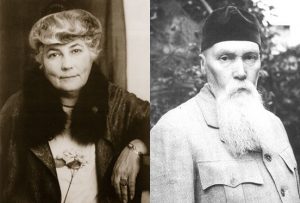
Helena and Nicholas Roerich. (Photo: Public Domain)
Shambhala is a fabled city-kingdom of the Himalayas, believed by Buddhists, Hindus and local shamans to exist simultaneously on the physical and the spiritual plane. For millennia, the legend of the underground kingdom played an important role in every Tibetan tradition and eventually, rumors of its existence reached the West.
It so happened that Helena Roerich, a writer and philosopher, had translated in Russian The Secret Doctrine, Madame Blavatsky’s influential esoteric work which first presented Shambhala as a shortcut to enlightenment. The Roerichs came to believe deeply in the Shambhala myth and at some point, while living in New York, Helena received telepathic instructions from “Master Morya”, an otherworldly entity, encouraging the couple to leave the U.S. and seek the city for themselves.
Unfortunately for the Roerichs, the area they aimed to investigate was all but inaccessible in the early 20th century. Tibet was closed to foreigners; moreover, the Soviets, the French, the English, the Chinese, the Japanese, the Mongolians and the Germans vied for control of the place. Spies, rebels and rogue warlords clashed daily in the mountain passes making the expedition extremely hazardous. The rivalry between the USSR and the British Empire in particular, was so intense it was nicknamed “the Great Game”.
However, it seems that upon arriving in Darjeeling the Roerichs had already managed to turn the hardships of the Great Game into an advantage—by offering themselves as pawns.
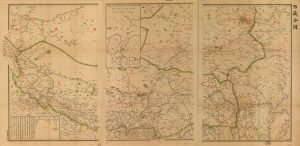
A map of Tibet, translated from Russian into Chinese, from 1904. (Photo: Library of Congress/2007628530)
After receiving permission from the Indian authorities, the Roerichs set out from Darjeeling towards the colorful monasteries of Sikkim, and then proceeded into the mainland. The couple’s eldest son, George, a noted Tibetologist, polyglot and student of military tactics was in charge of the group’s safety—not a small task, since the expedition was meant to last for years and cross 25,000 kilometers of previously uncharted roads. The Roerichs knew they would encounter scurvy, extreme weather, bandit groups and blocked mountain passages ahead.
Given the enormity of the task, the fact that they chose to make an unexpected detour through Moscow in 1926, was bound to raise questions. Why would the Roerichs cross into Russia, adding hardship to an already impossible trail? The most likely answer is that they were fulfilling a deal with their true sponsors in the quest for Shambhala—namely, the Soviet secret police.
What sounds like the plot of a particularly imaginative novel, has been extensively supported by scholars of modern Russia and early 20th century history. According to independent research by Richard Spence, Markus Osterrieder and Andrei Znamenski, several other world governments—China, Mongolia, Japan, Great Britain—took an interest in the hidden city, too. One of the reasons was an ancient Mongolian-Tibetan prophecy which, in the explosive political climate of the early 20th century, sounded convincing enough to turn some heads.
The prophecy declared that as materialism spread, humanity would eventually deteriorate. The people of the earth would be united under an evil king, who would soon attack Shambhala with fearful weapons. In time, the 32nd ruler of Shambhala would triumph over the bad king, and usher in a new era of peace and harmony. What today might sound like a standard doomsday prophecy could have had great implications back then, when borders constantly shifted and even great powers needed the support of local warlords.
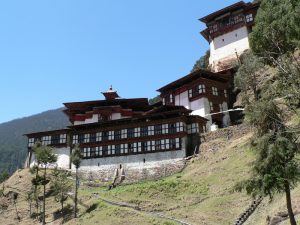 Chagri Monastery, Bhutan, where the first man to describe Shambhala to a western audience, Estêvão Cacella, stayed. (Photo: Stephen Shephard/CC BY-SA 3.0)
Chagri Monastery, Bhutan, where the first man to describe Shambhala to a western audience, Estêvão Cacella, stayed. (Photo: Stephen Shephard/CC BY-SA 3.0)
The Chinese and Russian governments in particular knew that among the peoples of central Asia, belief in the Kingdom of Shambhala was strong. Whoever managed to identify themselves with the forces of good, would gain the support of the surrounding peoples and thus gain control of the area. Once this was understood, several states became very interested in unearthing the underground kingdom.
Most of the officials intended to use Shambhala’s discovery for propaganda purposes, but some genuinely believed that they could also gain access to the hidden kingdom’s mystical weapons. One powerful man who truly believed in the prophecy was Gleb Bokii, a leader of the Cheka, the USSR’s Secret Police.
Bokii genuinely thought that the hidden city would offer him access to advanced weapons and mind controlling techniques, and managed to convince his superiors that the quest was worth looking into. The newly established USSR was receptive to the idea: even if there was no mystic armory to be found, if they managed to identify themselves with the hidden kingdom, they could enlist the help of Buddhists and nationalists in Mongolia and Tibet, thus strengthening their position in Central Asia.
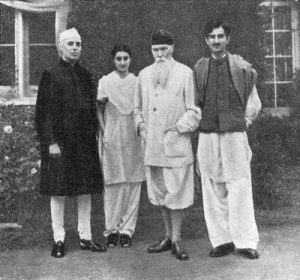 Jawaharlal Nehru, Indira Gandhi, Nicholas Roerich, and Mohammad Yunus at Roerich’s estate, Kullu. (Photo: Public Domain)
Jawaharlal Nehru, Indira Gandhi, Nicholas Roerich, and Mohammad Yunus at Roerich’s estate, Kullu. (Photo: Public Domain)
At the very least an expedition to search for Shambhala could spy on British activity in the area. However, Bokii was unable to secure funds for the mission due to internal rivalries at the Cheka, scholars Andrei Znamenski and Ernst von Waldenfels assert, and so he sought a roundabout solution: allying with Nicholas and Helena Roerich, celebrated scholars and Russian expatriates, who were famously planning their own expedition to the area, under a U.S. banner.
The Roerichs were not really political—they had conveniently left their native Russia just before the communist revolution and viewed “the Reds” with great distrust. However, when searching for a hidden underground kingdom one needs all the help they can get. Thankfully, Helena Roerich’s otherworldly pen pal “Master Morya” informed her that business needed to be done with the Bolsheviks in the interest of the world’s spiritual advancement; after receiving this mystical message, Helena wrote in her diary “Lenin is with us.”
It is very likely that Nicholas Roerich met with Chicherin, Soviet Secretary for foreign affairs, and Meer Trilisser, head of espionage, in Paris. There, the Soviets agreed to provide the couple with considerable financial and logistical help, in exchange for information on the movements of the French and British spies in the area. Gleb Bokii’s team, of course, had much higher expectations than espionage: they expected to get the ancient wisdom of the city itself.
Since the Roerichs were not trained spies, something of their true purpose leaked out while they waited in Darjeeling. Nicholas openly spoke of establishing in central Asia the Sacred Union of the East, a “spiritual commonwealth” uniting traditions of the area into a single state under the Bolsheviks’ protection. Several lamas found his cause worthwhile and flocked to him, which alerted other power groups in the area. It has even been suggested by historian Richard Spence, that in Darjeeling, the British contacted the Roerichs and made them a counter-offer—or simply threatened their lives should they continue.

Guests from Overseas by Nicholas Roerich. (Photo: Public Domain)
In any case, the Roerich expedition began its trek closely monitored by the British, the USSR and the Americans, as well as the Japanese, the Mongolians and the Chinese. In search of Shambhala, they would go through 35 mountain passes, cross the Gobi desert, and chart tens of alpine peaks for the first time. But from the beginning, they were beset with extreme weather, local rebel groups, armed bandits, poison grass which took their horses down, and caravan looters they could not avoid.
The couple’s travel diaries, along with Nicholas’ extraordinary paintings, provide a picture of the wonder and fear the travelers must have felt when crossing the terra incognita of the Himalayas. “Is the heart of Asia beating? Or has it suffocated by the sand?” Nicholas wondered as the expedition crossed Taklamakan desert.
As they moved on though, towards what they believed to be the hidden city, the trek became harder. The road was littered with animal skeletons—donkeys, mules and yaks. The expedition suffered from mountain-blindness, food was sparse and the U.S. flag was not enough to discourage attacks. The Roerichs remained optimistic: Nicholas was capable of finding beauty even in the blinding snowstorms which almost cost them their lives in the Karakorum mountain passages.
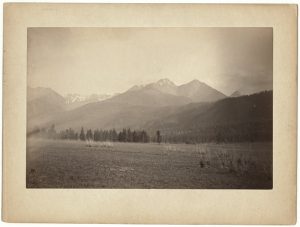 A view of the Altai Mountains, c. 1885. (Photo: Library of Congress/LC-USZ62-123330)
A view of the Altai Mountains, c. 1885. (Photo: Library of Congress/LC-USZ62-123330)
So how close did the Roerichs and Bekii get to their true purpose?
It is said that the closer one approaches to the hidden, hollow-earth city, the more vague their writings become, because Shambhala cannot be described in mere words. In his esoteric book Shambhala the Resplendent, which he was writing along with his more scientific and much drier travel diary, Nicholas began charting another, parallel journey written in stories and riddles. As the expedition went deeper, he increasingly recorded strange manifestations, fires, lights and visions over their camp —though those were mostly left out of his scientifically-minded travel diary.
His paintings also became more esoteric, increasingly depicting the messianic King of Shambhala. It is very likely that communication with the Soviets broke down at this point, after the country refused to provide more help to the Roerichs after the couple’s first visit to Moscow in 1926. After the Soviets withdrew their support, the strangest part of the entire journey came to pass: in the summer of 1927, the expedition, still watched over by most major powers of the era, managed to disappear from the eyes of the world for an entire year.
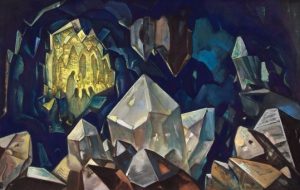
Roerich’s Most Sacred. (Photo: Public Domain)
Communication was lost, and the Roerichs were considered dead. Our only source for this invisible year is Nicholas’ travel diary —which contradicts his Shambhala the Resplendent narration—and speaks of violent conflict with the Tibetan armed forces. The only thing that is certain is that the last five months of their disappearance were spent in the Tibetan government’s detainment camp, where, due to the harsh conditions, five members of the expedition died.
After that, the Roerichs and their son trekked back to India. The closest they had gotten to Shambhala, according to Nicholas’ travel diaries, was in the Altai mountains, in the valley of Uimon, when an “Old Believer” proudly showed them the entrance to the subterranean kingdom, now barred with stones. The true denizens of Shambhala would return, he assured the Roerichs, in the glorious time of human purification. Till then, the rest of humanity would only hear the echoes of their chanting.
If the Roerichs were spying for the British or the Soviets, the U.S. did not hold it against them. They remained close to Franklin Delano Roosevelt, a correspondent of Helena, whose administration sponsored the couple’s next Asian expedition in Manchuria in 1933. Roerich used the opportunity to keep searching for Shambhala, this time touting American leaders as the messianic figures soon to lead the war against evil, which was now represented by the Bolsheviks.
 Helena Blavatsky, c. 1875, the Russian spiritualist whose works introduced the Roerichs to Shambhala. (Photo: Public Domain)
Helena Blavatsky, c. 1875, the Russian spiritualist whose works introduced the Roerichs to Shambhala. (Photo: Public Domain)
The second time around though, those who thought Nicholas Roerich to be a Soviet spy and a weird mystic were much more vocal. Eventually, their concerns forced the government to recall the couple early, despite the scientific success of the expedition. At the time, being suspected of collaboration with the Soviets could prove fatal so the Roerichs left the U.S. and settled in India.
However, the scientific worth of their expedition cannot be underestimated: no matter their motives, they had trekked miles of unchartered lands, unearthed lost artifacts and catalogued flora and fauna previously unknown to the West. Despite the controversy surrounding his name, Nicholas would garner three Nobel Peace Prize nominations, and also establish the Roerich pact, an inter-American treaty protecting cultural artifacts in times of conflict; the Roerichs even had a planet named after them in 1969.
As for Shambhala, it still awaits the next explorer, hidden inside a hollow earth.
READ MORE AT http://www.atlasobscura.com/articles/why-the-soviets-sponsored-a-doomed-expedition-to-a-hollow-earth-kingdom







